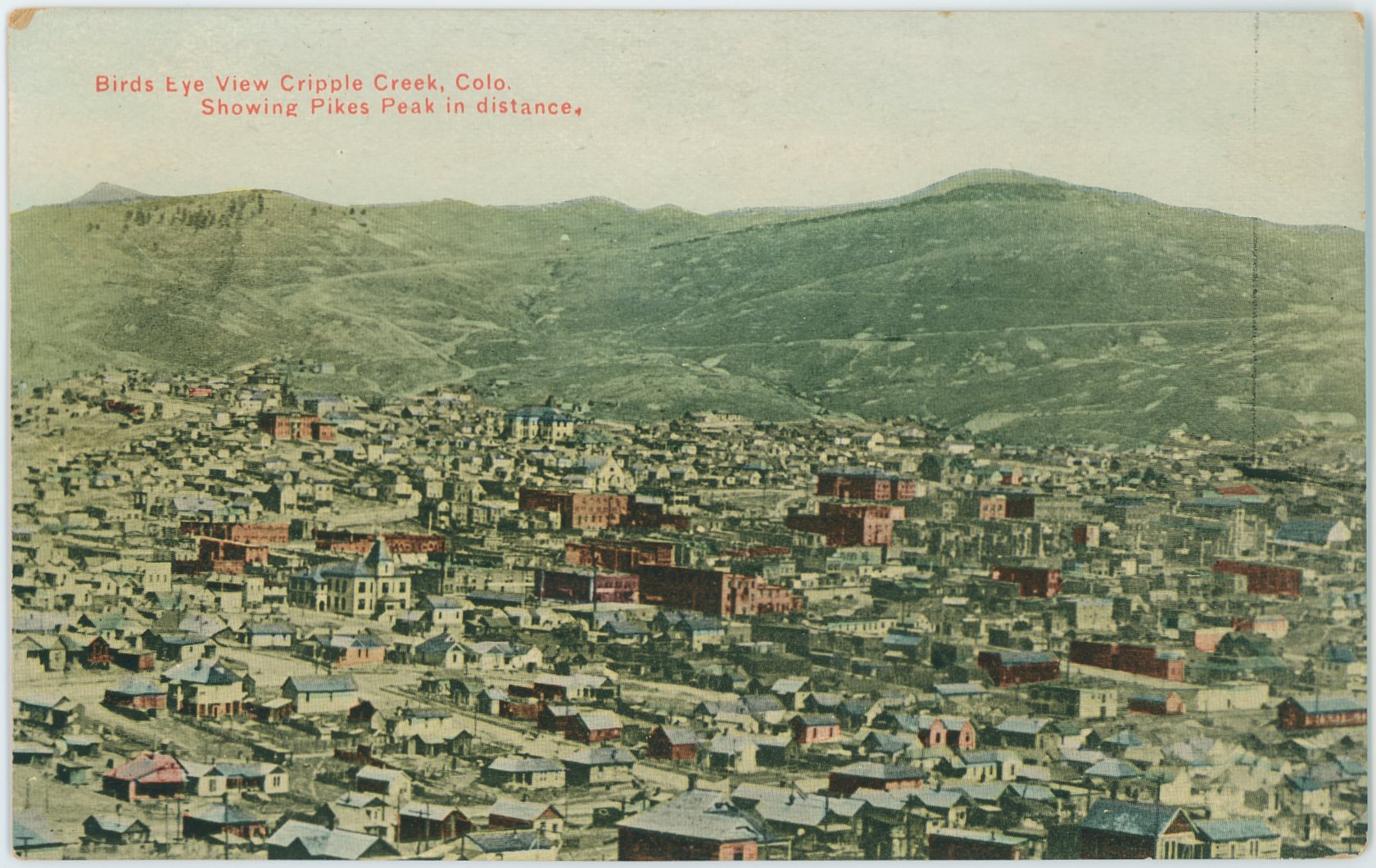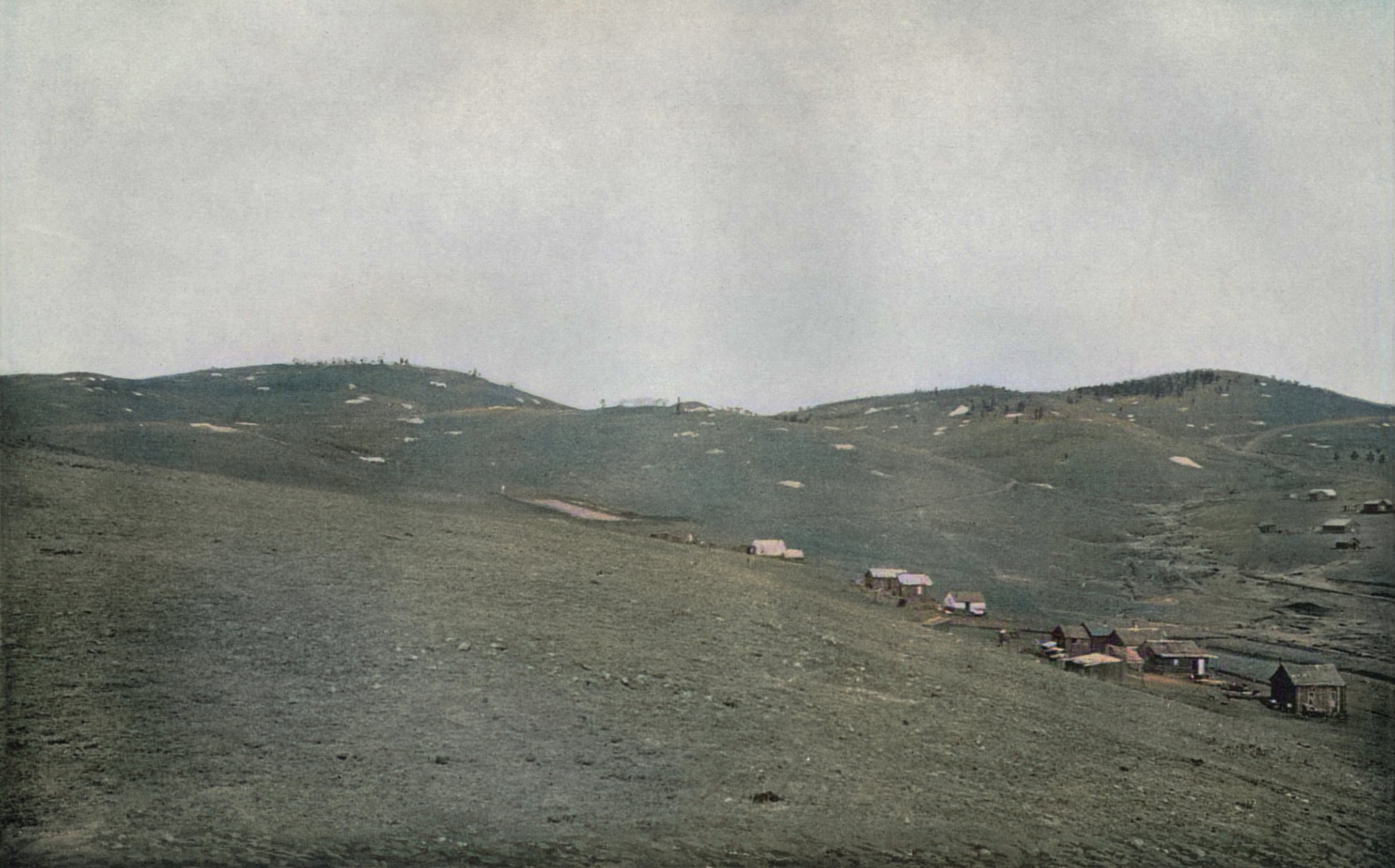-> HathiTrust Digital Library Site; Link to First main text page of article.
Source was text only, so I added pics from my collection
Tellurides of the precious metals or of base metals associated with ores of the precious metals have been found in a considerable number of American localities. The list embraces the southern Appalachian gold belt, Texas, the Black Hills of South Dakota, Colorado, Montana, Idaho, Arizona, Utah, and California. They were first recognized in gold ores from Virginia, and subsequently in several other southern States. California was the next locality, and then Boulder County, Colorado, after which came the others.
El Paso County.—Cripple Creek is the one camp of importance in El Paso County. The productive mines are situated in the foot-hills of Pike's Peak, about 10 miles west of the peak itself. The general country rock of the region is the red granite of Pike's Peak. This contains masses of still older mica schists presumably caught up in its intrusion. The schists are pre-Cambrian, as are the granites, and contain diabase dikes, which occur in the streets of Cripple Creek, and on Mineral Hill, but are of no importance in connection with the ores.
At the close of the Eocene or in the Miocene times a small volcanic center broke out in the granite hills now lying east of the town and perhaps elsewhere. It was marked at first by explosive activity that besprinkled the neighboring region with a breccia made up of fragments of granite and andesite.
Later came eruptions of several varieties of phonolite, which form many dikes associated with the ore bodies. Some minor outcrops of nepheline-syenite and syenite-porphyry are possibly deep-seated and coarsely crystalline representatives of the phonolite magma. Explosive eruptions of this phase seem also to have contributed some phonolite to later breccias. Last of all, dikes of several kinds of basalt, including nepheline-basalt, feldspar-basalt, and limburgite, closed the eruptive phenomena.
The breccias, after their formation, became in many cases silicified, producing a very firm rock, and as a rule are so altered that their rock is to be recognized more by its physical texture than by its mineralogy. In areal distribution the breccias are the most prominent rocks near the mines. Next follows the granite, while through both are intruded the dikes of phonolites and basalts.
The ores are almost entirely productive of gold, for although some little silver is often with it, and although lead, zinc, and copper minerals are met in one or two mines, the former is of slight economic account, and the latter are rarities. Iron pyrites is very widespread, but it is not a great carrier of gold. The real source is the telluride of gold, calaverite, from which more or less of the native metal has been derived by oxidation in the upper parts of the veins.
As announced by A. H. Chester before the New York Academy of Sciences, Feb. 21, 1898, krennerite is probably present in the Independence.
The gangue minerals are quartz, fluorite, and decomposed country rock. When the latter is granite it has lost its mica and often its quartz, leaving a cellular rock more or less impregnated with fresh or decomposed telluride. The wash of these veins has yielded some placer diggings especially on Mineral Hill.
The ore deposits are true veins, which have been formed along lines of displacement whose amount is as a rule slight. The fissures themselves are often insignificant in appearance, but the impregnation of the wall-rock with ore to a width of from one to several feet may afford very rich and valuable ore bodies. The fissures frequently follow the courses of dikes, but are clearly later than the latter because they cross them, leave them, return to them, and behave in a more or less independent way.
Yet the presence of dikes is in a measure a favorable thing, because the dike itself has filled a fissure, and because it, being an offshoot from a larger body of heated rock and with lines of weakness along the contacts with its walls, doubtless has often exercised a directing influence on solutions.
The veins are not large, but they have yielded in the aggregate huge amounts of high-grade ore. As elsewhere the ores follow shoots in the veins, and the shoots approximate the vertical. Small cross-fractures have often exercised an influence upon them. The veins themselves are also often in a series of small parallel fissures, rather than in a single one, and impregnate the intervening walls.
Ore has been found in blind veins, outside the main lines of deposition, so that frequent cross-cuts are desirable to make sure of the country. The most productive section is on Battle Mountain, just above Victor. The Portland group and the famous Independence are in this hill.
Bull Mountain with its spur, Bull Cliff, contains a considerable number of veins around the town of Altman. The fissure on which the Buena Vista, Lee, and Victor mines are located is one of the most extended in the district. Raven Hill, Gold Hill, Globe Hill, and various minor spurs have also yielded important bodies of ore.*
- W. P. Blake, "The Gold of Cripple Creek", Engineering and Mining Journal, January 13, 1894.
- Whitman Cross, "Pike's Peak Atlas Folio of the U. S. Geological Survey."
- Whitman Cross and R. A. F. Penrose, Jr., "Geology and Mining Industries of the Cripple Creek District, Colorado", 16th Annual Report of the Director of the U. S. Geological Survey, 1894-95.
- W. F. Hillebrand, "Chemical Composition of Calaverite from Cripple Creek", in Cross and Penrose Report (16th Annual Report of the Director of the U. S. Geological Survey), page 133.
- W. F. Hillebrand, "Calaverite from Cripple Creek, Colo.", American Journal of Science, August 1895, page 128.
- F. C. Knight, "On the Composition of the Cripple Creek Telluride", Proceedings of the Colorado Scientific Society, October 1, 1894.
- H. L. McCann. "Notes on the Geology of the Gold Field of Cripple Creek, Colo.", Science, January 19, 1894.
- R. Pearce, "The Mode of Occurrence of Gold in the Ores of Cripple Creek District", Proceedings of the Colorado Scientific Society, January 8, 1894.
- R. Pearce, "The Mode of Occurrence of Gold in the Ores of Cripple Creek District", Engineer and Mining Journal, March 24, 1894.
- R. Pearce, "Further Notes on Cripple Creek Ores", Proceedings of the Colorado Scientific Society, April 5, 1894.
- S. L. Penfield, "On Calaverite Crystals from Cripple Creek", Cross and Penrose Report (16th Annual Report of the Director of the U. S. Geological Survey), page 135.
- E. Skewes and H. J. Eder, "The Victor Mine, Cripple Creek, Colo.", Engineering and Mining Journal, August 19, 1893, page 193.
- E. Skewes, "The Ore-shoots of Cripple Creek", Transactions of the American Institute of Mining Engineers, XXVI., 1896, page 553.
- George H. Stone, "The Granitic Breccias of the Cripple Creek Region", American Journal of Science, January 1898, page 21.

